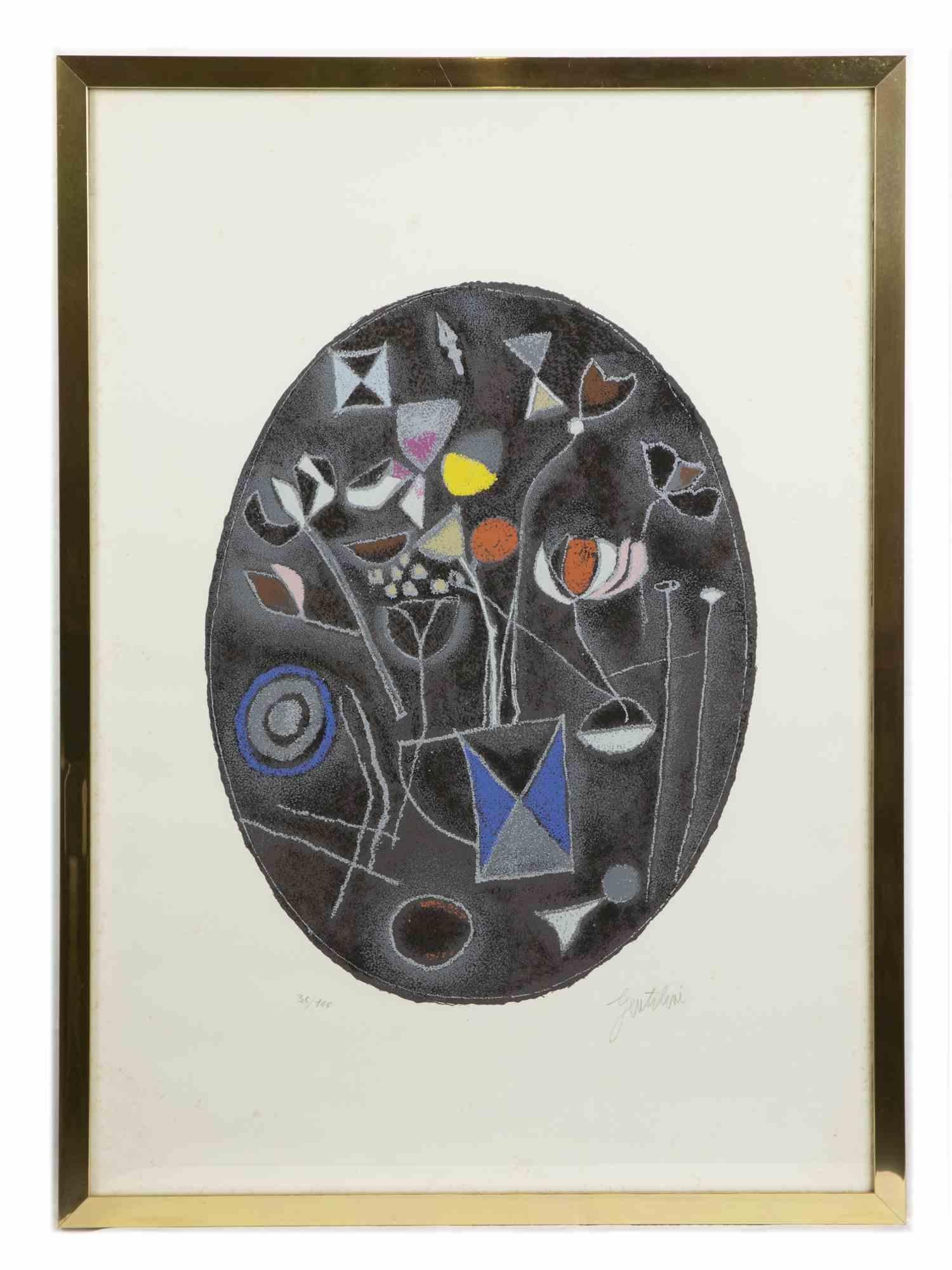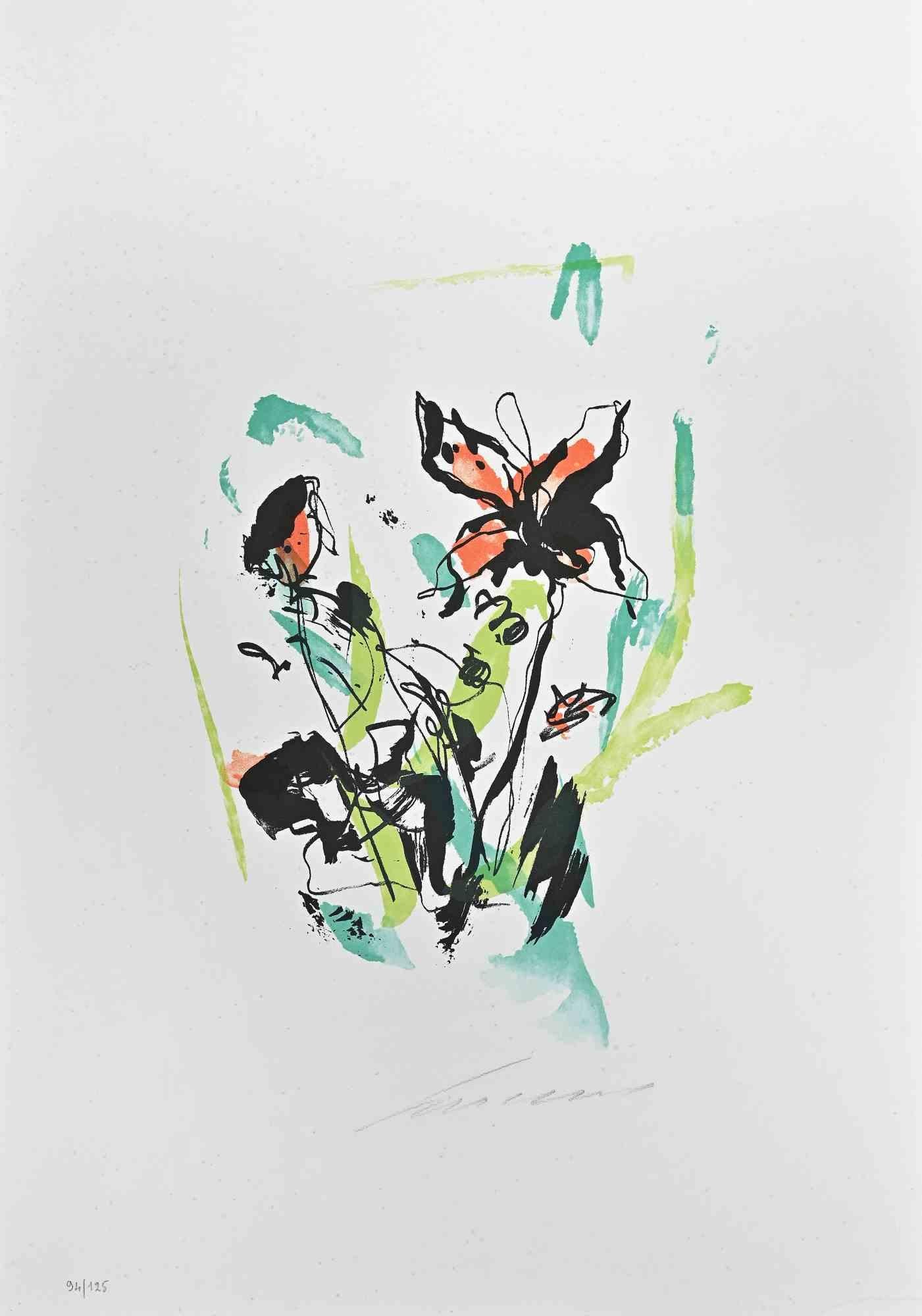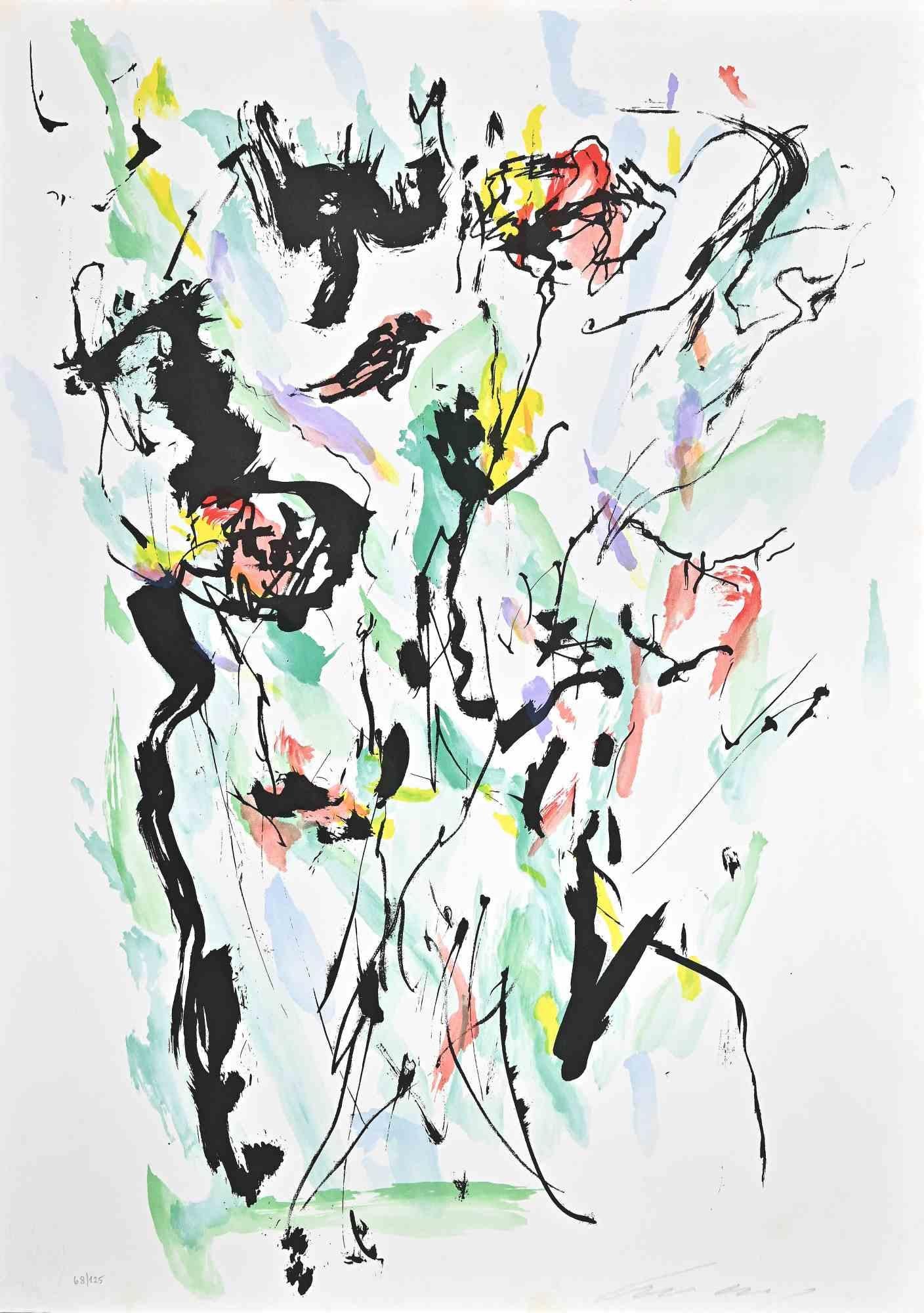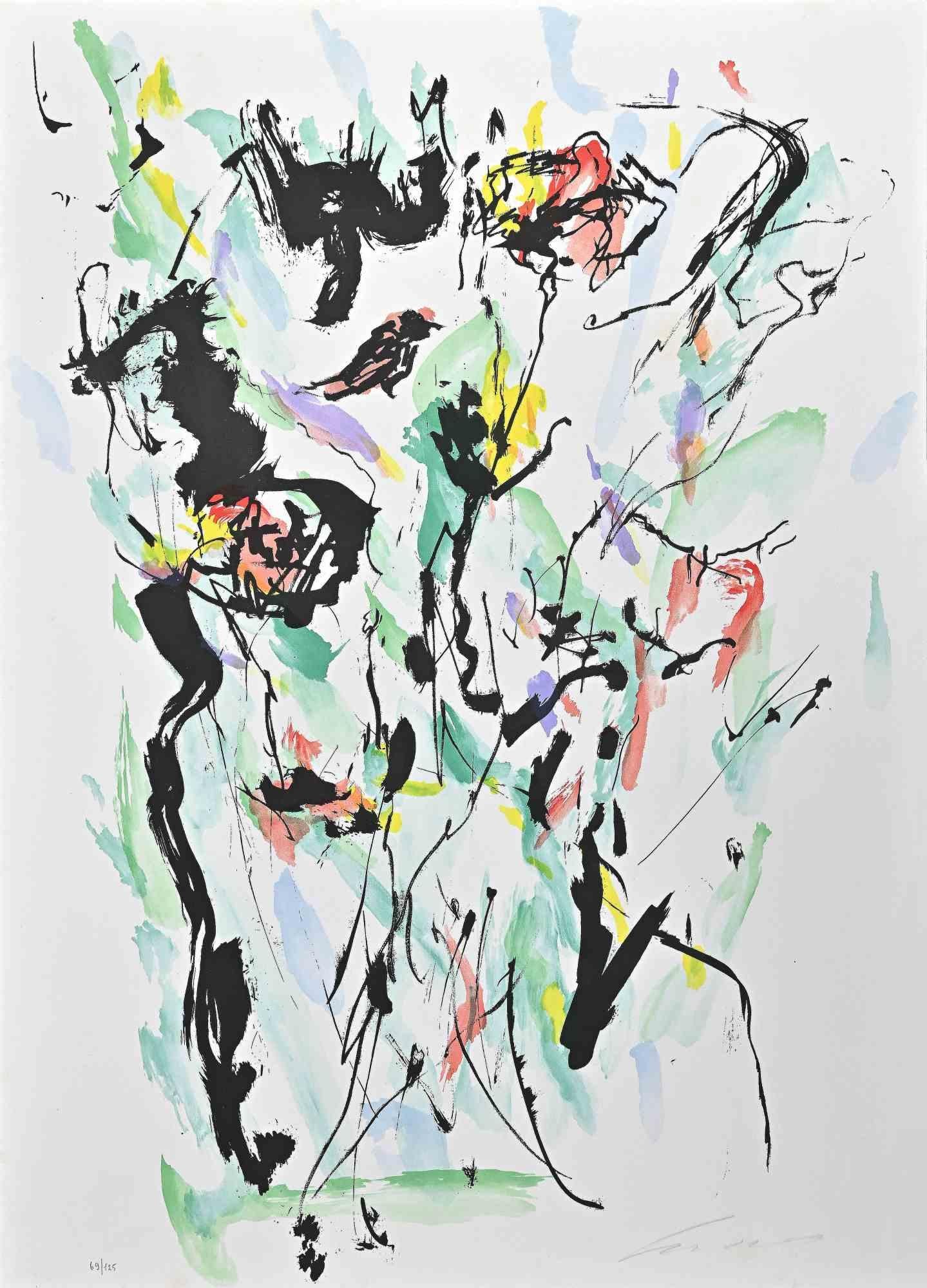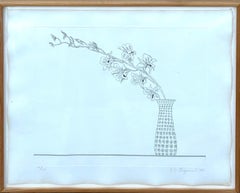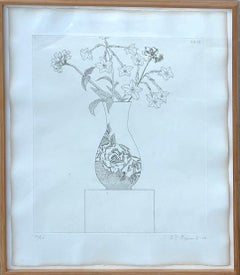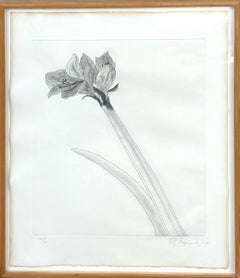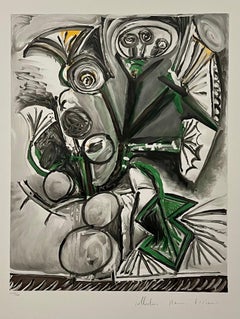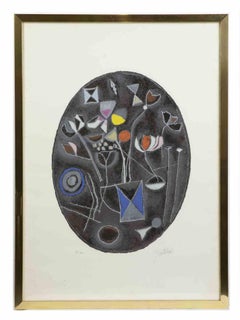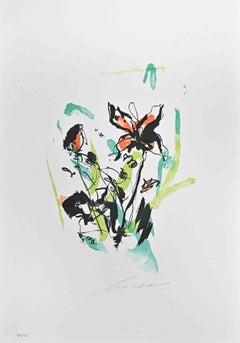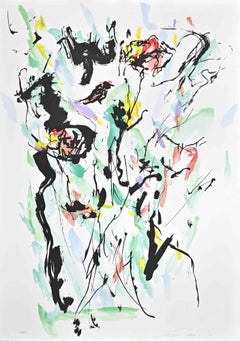Items Similar to Whimsical Abstract Flowers, Lithograph, Signed, Ed. 6 of 30
Want more images or videos?
Request additional images or videos from the seller
1 of 8
Yehoshua KovarskyWhimsical Abstract Flowers, Lithograph, Signed, Ed. 6 of 30
$650
£504.94
€572.93
CA$929.38
A$1,016.76
CHF 531.04
MX$12,150.55
NOK 6,671.73
SEK 6,279.15
DKK 4,278.56
About the Item
Yehoshua Kovarsky
1907-1967
Kovarsky was born in the city of Vilna, Lithuania to a traditional Jewish family. His father and uncle owned a concession for painting railroad stations, trains and bridges, and were responsible for commissioning artists to execute murals.
Between the years 1920-1925, Kovarsky attended a Yiddish Gymnasia in Vilna and later a governmental school of art. At the age of 17, he was sent to Palestine, where he worked on a “Kibbutz” (collective settlement) for a period of time, during this time he drained swamps, paved roads and worked in citrus groves. He attended the Bezalel Academy of Art and Design in Jerusalem for a short time, and worked for the young Hebrew Theater in Tel- Aviv as a set designer and wanted to become an actor.
In 1928, Kovarsky returned to Vilna and studied in the Academy of Fine Arts where he had his first exhibition. He went to Paris in 1931, with his parents’ expectations that he would study law. Instead, he joined the art studios of Paul Colin (1892-1985) and Andre Lhote (1885-1962).
In 1936 he came back to Israel. He stayed in Tel- Aviv and worked as a decorator for the Levant Fair. In 1938, he returned to France and worked in his brother’s home in Metz. When World War II broke out, Kovarsky fled to Palestine leaving behind most of his works, which were ruined in the raids.
In his first few years in Israel he isolated himself in order to focus on painting. Most of his paintings from this period are of the ancient city of Safad- cradle of Jewish mysticism and Cabalism, Which was also known as a colony of artists. In 1944 he moved to Zichron Ya’acov and taught art in Shfeye. 1n 1949, he settled in Jerusalem and a year later he married Corinne Chochem, a Martha Graham dancer.
In 1951, although already established as a known artist in Israel, Kovarsky and his wife decided to move to the USA. First they traveled in California and North Carolina, and then settled in New York City. In 1954, he exhibited in the annual exhibition of the Pennsylvania Academy of Fine Art. In 1957, Kovarsky returned again to Israel for two years and then came back to New York. From1959 on, he lived in Los Angeles. In 1967, a short time after the Six Days War, Yehoshua Kovarsky died. Kovarsky and his wife always planned on returning to Israel to retire, but unfortunately they never got the chance to do so.
The artist’s stay in Paris and New York is reflected in his work. He absorbed all the Surrealists’ ideas, the interest in Mythology, Archetypes and the depth of the self that were popular in 1920’s Paris, and that have matured into the Abstract Expressionism in the mid 1940’s in New York. For Kovarsky, above all, painting was a mean of discovering the true self, as he himself had expressed:
“The image is hiding somewhere inside, you try to fix it and you get closer to what is hiding inside of you…you have more then you are able to express and that is way you are trying to go back inside…it is the same as trying to reach god- higher you go, he is still remains higher then you”. (1966)
Kovarksy exhibited at many places including: Katz gallery, Tel Aviv; Pasadena Art Museum; San Francisco Museum of Art; Passedoit Gallery, New York; Tel Aviv Museum; Cincinnati Art Museum; Schneider Gallery, Rome; Gallery One, London; Santa Barbara Museum of Art; Jewish Museum, New York; University of Haifa, Haifa, among others.
His work is in the collections of the following institutions: San Francisco Museum of Art, Pasadena Art Museum, Mint Museum of Art, Charlotte, NC, Jewish Museum, New York, New Sinai Temple, Los Angeles, Tel Aviv Museum, Bezalel Museum, Jersalem, Ein Harod Museum, Ain-Harod, and the University of Haifa, Haifa. Many other works are in private collections in the United States and Israel.
- Creator:Yehoshua Kovarsky (1907-1967, Lithuanian)
- Dimensions:Height: 18.25 in (46.36 cm)Width: 23 in (58.42 cm)
- Medium:
- Movement & Style:
- Period:
- Condition:Age toning to paper, frame has wear.
- Gallery Location:Surfside, FL
- Reference Number:Seller: 7471stDibs: LU38212174612
About the Seller
4.9
Platinum Seller
Premium sellers with a 4.7+ rating and 24-hour response times
Established in 1995
1stDibs seller since 2014
1,830 sales on 1stDibs
Typical response time: 1 hour
- ShippingRetrieving quote...Shipping from: Surfside, FL
- Return Policy
More From This Seller
View AllZen Minimalist Flowers Etching American Modernist Ed Baynard Pop Art Print
By Ed Baynard
Located in Surfside, FL
ED BAYNARD (American, 1940-2016)
Flowers, Flowers in a Vase, Etching.
1979/1980,
Hand signed, dated l.r.,
Hand numbered from small edition 12/24,
Dimensions: 23 by 19 in. Framed 25 by 21 in
Born in Washington, D.C. in 1940. Raised in Washington, D.C. and newly graduated from high school, he flew to Europe living off and on in Paris and London. During this time, he designed costumes for Jimi Hendrix, worked as a graphic designer for the Beatles as well as Elizabeth Taylor and Richard Burton. Returning to New York, he dedicated his life to art after a surprise success with his first show in 1971 at the Willard Gallery in NYC. Ed's images are Zen-like in their simplicity and grace rendered in a flat, graphic style that recalls Japanese Ukiyo-e prints. His watercolors are luminous, like the rest of his representations regardless of the medium. The Japanese inspired ukiyo-e style woodblock prints and lithograph works he created at Tyler Graphics in 1980 contain a 20th century "floating world" sensibility. Ed's wish was to bring harmony, color, and a meditative stillness to this chaotic planet. He did so in a gentle and powerful way, always as an expression of his deep gratitude for the love and beauty, friendship, and concerns he held dearest. His first solo exhibition was in 1971 at New York's legendary Willard Gallery on the recommendation of Agnes Martin. Baynard went on to have exhibitions at galleries including Betty Parsons Gallery, New York (1973); Marian Goodman Gallery, New York (1977); John Berggruen Gallery, San Francisco (1980); and Barbara Gladstone Gallery, New York (1980/81).. Baynard manages to retain a simplicity of form inspired by a love of Japanese Woodblock prints. His new works reflect the same poetry of his earlier paintings, retaining his stylized compositions with their Zen like minimalism and Oriental calm, along with a new sense of rhythm and movement. Baynard uses familiar themes such as flowers, plants, pots, and vases, incorporating them into his delicate watercolor still lifes, thus creating stunning visual feasts. He was included in the 1972 Landscape exhibition at MoMA NY alone with other luminaries James Boynton...
Category
1980s American Modern Still-life Prints
Materials
Etching
Zen Minimalist Flowers Etching American Modernist Ed Baynard Pop Art Print
By Ed Baynard
Located in Surfside, FL
ED BAYNARD (American, 1940-2016)
Flowers, Flowers in a Vase, Etching.
1979/1980,
Hand signed, dated l.r.,
Hand numbered from small edition 12/24,
Dimensions: 23 by 19 in. Framed 25 by 21 in
Born in Washington, D.C. in 1940. Raised in Washington, D.C. and newly graduated from high school, he flew to Europe living off and on in Paris and London. During this time, he designed costumes for Jimi Hendrix, worked as a graphic designer for the Beatles as well as Elizabeth Taylor and Richard Burton. Returning to New York, he dedicated his life to art after a surprise success with his first show in 1971 at the Willard Gallery in NYC. Ed's images are Zen-like in their simplicity and grace rendered in a flat, graphic style that recalls Japanese Ukiyo-e prints. His watercolors are luminous, like the rest of his representations regardless of the medium. The Japanese inspired ukiyo-e style woodblock prints and lithograph works he created at Tyler Graphics in 1980 contain a 20th century "floating world" sensibility. Ed's wish was to bring harmony, color, and a meditative stillness to this chaotic planet. He did so in a gentle and powerful way, always as an expression of his deep gratitude for the love and beauty, friendship, and concerns he held dearest. His first solo exhibition was in 1971 at New York's legendary Willard Gallery on the recommendation of Agnes Martin. Baynard went on to have exhibitions at galleries including Betty Parsons Gallery, New York (1973); Marian Goodman Gallery, New York (1977); John Berggruen Gallery, San Francisco (1980); and Barbara Gladstone Gallery, New York (1980/81).. Baynard manages to retain a simplicity of form inspired by a love of Japanese Woodblock prints. His new works reflect the same poetry of his earlier paintings, retaining his stylized compositions with their Zen like minimalism and Oriental calm, along with a new sense of rhythm and movement. Baynard uses familiar themes such as flowers, plants, pots, and vases, incorporating them into his delicate watercolor still lifes, thus creating stunning visual feasts. He was included in the 1972 Landscape exhibition at MoMA NY alone with other luminaries James Boynton...
Category
1980s American Modern Still-life Prints
Materials
Etching
Zen Minimalist Flowers Aquatint Etching American Modernist Ed Baynard Pop Art
By Ed Baynard
Located in Surfside, FL
ED BAYNARD (American, 1940-2016)
Flowers, Flowers in a Vase, Aquatint Etching.
1979/1980,
Hand signed, dated l.r.,
Hand numbered from small edition 12/24,
Dimensions: 23 by 19 in. Framed 25 by 21 in
Born in Washington, D.C. in 1940. Raised in Washington, D.C. and newly graduated from high school, he flew to Europe living off and on in Paris and London. During this time, he designed costumes for Jimi Hendrix, worked as a graphic designer for the Beatles as well as Elizabeth Taylor and Richard Burton. Returning to New York, he dedicated his life to art after a surprise success with his first show in 1971 at the Willard Gallery in NYC. Ed's images are Zen-like in their simplicity and grace rendered in a flat, graphic style that recalls Japanese Ukiyo-e prints. His watercolors are luminous, like the rest of his representations regardless of the medium. The Japanese inspired ukiyo-e style woodblock prints and lithograph works he created at Tyler Graphics in 1980 contain a 20th century "floating world" sensibility. Ed's wish was to bring harmony, color, and a meditative stillness to this chaotic planet. He did so in a gentle and powerful way, always as an expression of his deep gratitude for the love and beauty, friendship, and concerns he held dearest. His first solo exhibition was in 1971 at New York's legendary Willard Gallery on the recommendation of Agnes Martin. Baynard went on to have exhibitions at galleries including Betty Parsons Gallery, New York (1973); Marian Goodman Gallery, New York (1977); John Berggruen Gallery, San Francisco (1980); and Barbara Gladstone Gallery, New York (1980/81).. Baynard manages to retain a simplicity of form inspired by a love of Japanese Woodblock prints. His new works reflect the same poetry of his earlier paintings, retaining his stylized compositions with their Zen like minimalism and Oriental calm, along with a new sense of rhythm and movement. Baynard uses familiar themes such as flowers, plants, pots, and vases, incorporating them into his delicate watercolor still lifes, thus creating stunning visual feasts. He was included in the 1972 Landscape exhibition at MoMA NY alone with other luminaries James Boynton...
Category
1980s American Modern Still-life Prints
Materials
Etching
Pablo Picasso Estate Hand Signed Cubist Lithograph Abstract Flowers Bouquet
By Pablo Picasso
Located in Surfside, FL
Pablo Picasso (after)
"Le Bouquet" Bouquet of flowers, abstract floral arrangement.
limited edition print on Arches paper,
Hand signed by Marina Picasso lower right and numbered 244...
Category
20th Century Modern Abstract Prints
Materials
Lithograph
Zen Minimalist Flowers Etching American Modernist Ed Baynard Pop Art Print
By Ed Baynard
Located in Surfside, FL
ED BAYNARD (American, 1940-2016)
Flowers, Flowers in a Vase, Etching.
1979/1980,
Hand signed, dated l.r.,
Hand numbered from small edition 12/24,
Dimensions: 23 by 19 in. Framed 25 by 21 in
Born in Washington, D.C. in 1940. Raised in Washington, D.C. and newly graduated from high school, he flew to Europe living off and on in Paris and London. During this time, he designed costumes for Jimi Hendrix, worked as a graphic designer for the Beatles as well as Elizabeth Taylor and Richard Burton. Returning to New York, he dedicated his life to art after a surprise success with his first show in 1971 at the Willard Gallery in NYC. Ed's images are Zen-like in their simplicity and grace rendered in a flat, graphic style that recalls Japanese Ukiyo-e prints. His watercolors are luminous, like the rest of his representations regardless of the medium. The Japanese inspired ukiyo-e style woodblock prints and lithograph works he created at Tyler Graphics in 1980 contain a 20th century "floating world" sensibility. Ed's wish was to bring harmony, color, and a meditative stillness to this chaotic planet. He did so in a gentle and powerful way, always as an expression of his deep gratitude for the love and beauty, friendship, and concerns he held dearest. His first solo exhibition was in 1971 at New York's legendary Willard Gallery on the recommendation of Agnes Martin. Baynard went on to have exhibitions at galleries including Betty Parsons Gallery, New York (1973); Marian Goodman Gallery, New York (1977); John Berggruen Gallery, San Francisco (1980); and Barbara Gladstone Gallery, New York (1980/81).. Baynard manages to retain a simplicity of form inspired by a love of Japanese Woodblock prints. His new works reflect the same poetry of his earlier paintings, retaining his stylized compositions with their Zen like minimalism and Oriental calm, along with a new sense of rhythm and movement. Baynard uses familiar themes such as flowers, plants, pots, and vases, incorporating them into his delicate watercolor still lifes, thus creating stunning visual feasts. He was included in the 1972 Landscape exhibition at MoMA NY alone with other luminaries James Boynton...
Category
1980s American Modern Still-life Prints
Materials
Etching
Zen Minimalist Flowers Etching American Modernist Ed Baynard Pop Art Print
By Ed Baynard
Located in Surfside, FL
ED BAYNARD (American, 1940-2016)
Flowers, Flowers in a Vase, Etching.
1979/1980,
Hand signed, dated l.r.,
Hand numbered from small edition 12/24,
Dimensions: 23 by 19 in. Framed 25 by 21 in
Born in Washington, D.C. in 1940. Raised in Washington, D.C. and newly graduated from high school, he flew to Europe living off and on in Paris and London. During this time, he designed costumes for Jimi Hendrix, worked as a graphic designer for the Beatles as well as Elizabeth Taylor and Richard Burton. Returning to New York, he dedicated his life to art after a surprise success with his first show in 1971 at the Willard Gallery in NYC. Ed's images are Zen-like in their simplicity and grace rendered in a flat, graphic style that recalls Japanese Ukiyo-e prints. His watercolors are luminous, like the rest of his representations regardless of the medium. The Japanese inspired ukiyo-e style woodblock prints and lithograph works he created at Tyler Graphics in 1980 contain a 20th century "floating world" sensibility. Ed's wish was to bring harmony, color, and a meditative stillness to this chaotic planet. He did so in a gentle and powerful way, always as an expression of his deep gratitude for the love and beauty, friendship, and concerns he held dearest. His first solo exhibition was in 1971 at New York's legendary Willard Gallery on the recommendation of Agnes Martin. Baynard went on to have exhibitions at galleries including Betty Parsons Gallery, New York (1973); Marian Goodman Gallery, New York (1977); John Berggruen Gallery, San Francisco (1980); and Barbara Gladstone Gallery, New York (1980/81).. Baynard manages to retain a simplicity of form inspired by a love of Japanese Woodblock prints. His new works reflect the same poetry of his earlier paintings, retaining his stylized compositions with their Zen like minimalism and Oriental calm, along with a new sense of rhythm and movement. Baynard uses familiar themes such as flowers, plants, pots, and vases, incorporating them into his delicate watercolor still lifes, thus creating stunning visual feasts. He was included in the 1972 Landscape exhibition at MoMA NY alone with other luminaries James Boynton...
Category
1980s American Modern Still-life Prints
Materials
Etching
You May Also Like
Abstract Flowers - Lithograph by Franco Gentilini - 1970s
By Franco Gentilini
Located in Roma, IT
Abstract Flowers is an original modern artwork realized in the1970s by Franco Gentilini.
Mixed colored lithograph
Hand signed and dated on the lower margin.
Edition of 35/100
Inc...
Category
1970s Modern Abstract Prints
Materials
Lithograph
Flowers - Lithograph by Ernesto Treccani - 1973
By Ernesto Treccani
Located in Roma, IT
Flowers is a Lithograph realized by Ernesto Treccani in 1973.
Limited edition of 125, editor "La Nuova Foglio SPA".
Very good condition on a white cardboard.
Hand-signed and numbe...
Category
1970s Modern Figurative Prints
Materials
Lithograph
Flowers - Lithograph by Ernesto Treccani - 1973
By Ernesto Treccani
Located in Roma, IT
Flowers is an Original Lithograph realized by Ernesto Treccani in 1973.
Limited edition of 125 copies, editor "La Nuova Foglio SPA".
Very good condition on a white cardboard.
Hand...
Category
1970s Modern Abstract Prints
Materials
Lithograph
Spring's Passion, Signed Floral Lithograph by Helen Covensky
By Helen Covensky
Located in Long Island City, NY
Spring’s Passion by Helen Covensky, Polish/American (1925–2007)
Date: 1980
Lithograph, signed and numbered in pencil
Edition of 225
Image Size: 18.5 x 27 inches
Size: 22 in. x 29 in....
Category
1980s Abstract More Prints
Materials
Lithograph
Flowers- Lithograph by Ernesto Treccani - 1973
By Ernesto Treccani
Located in Roma, IT
Flowers is an Original Lithograph realized by Ernesto Treccani in 1973.
Limited edition of 125 copies, editor "La Nuova Foglio SPA".
Very good condition on a white cardboard.
Hand...
Category
1970s Abstract Figurative Prints
Materials
Lithograph
Flowers II, Signed Floral Lithograph by Helen Covensky
By Helen Covensky
Located in Long Island City, NY
Flowers II by Helen Covensky, Polish/American (1925–2007)
Date: 1980
Lithograph, signed and numbered in pencil
Edition of 225
Image Size: 18.5 x 26 inches
Size: 22 in. x 29 in. (55.8...
Category
1980s Abstract More Prints
Materials
Lithograph
